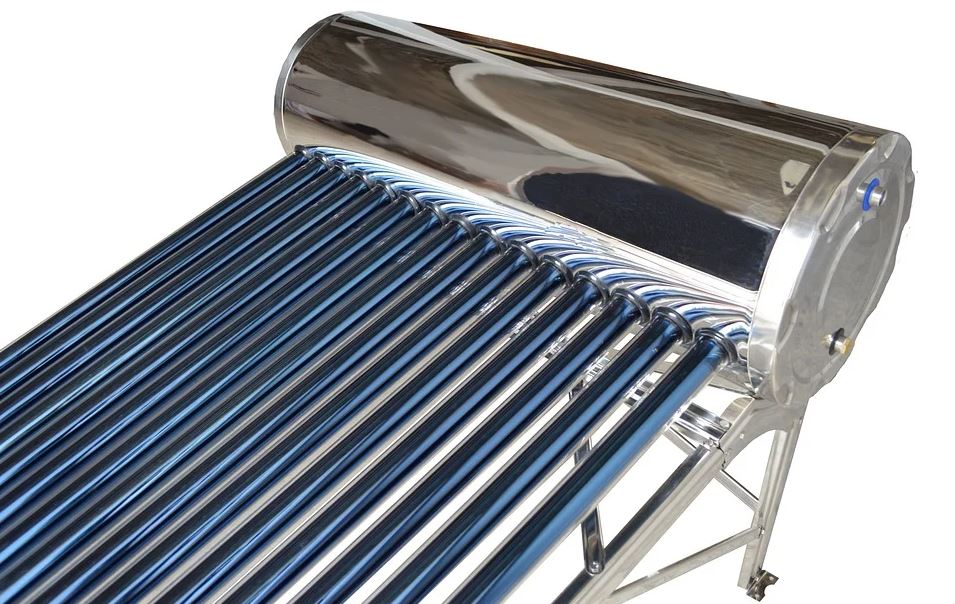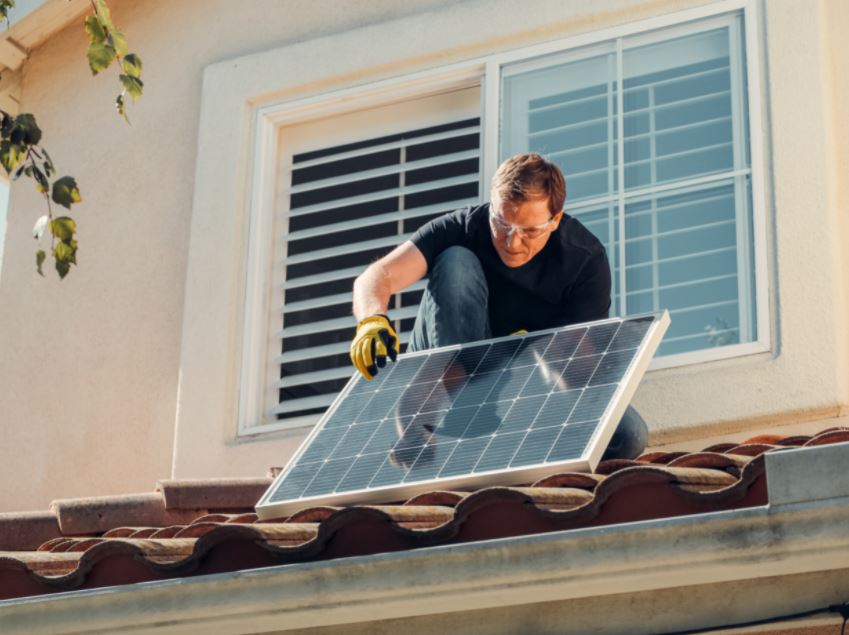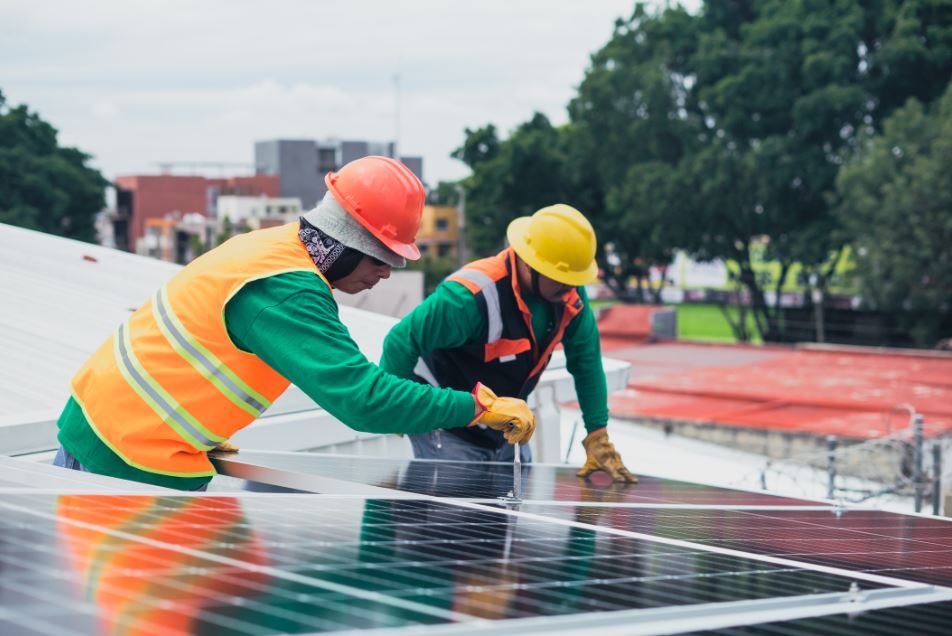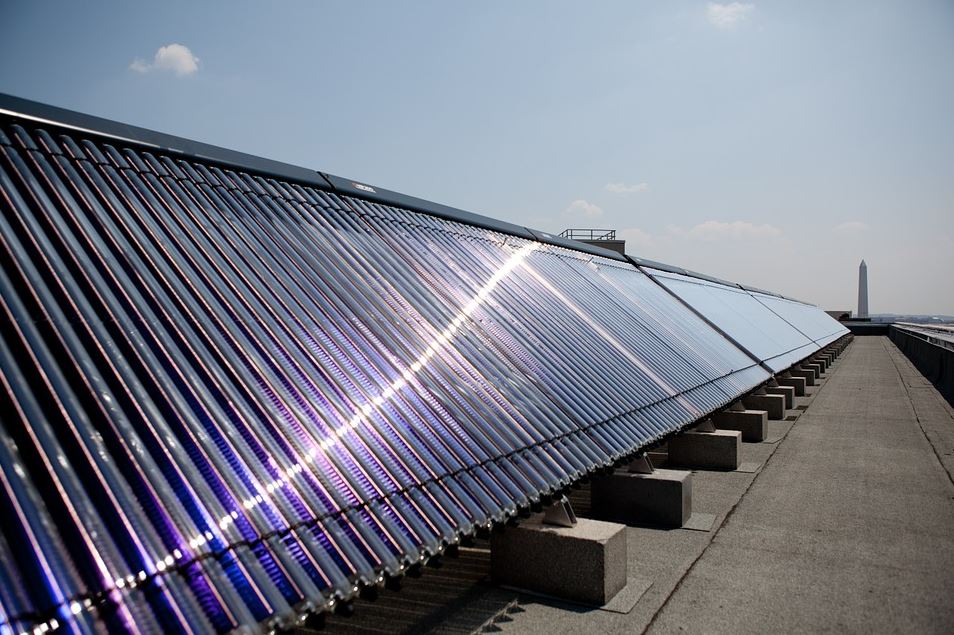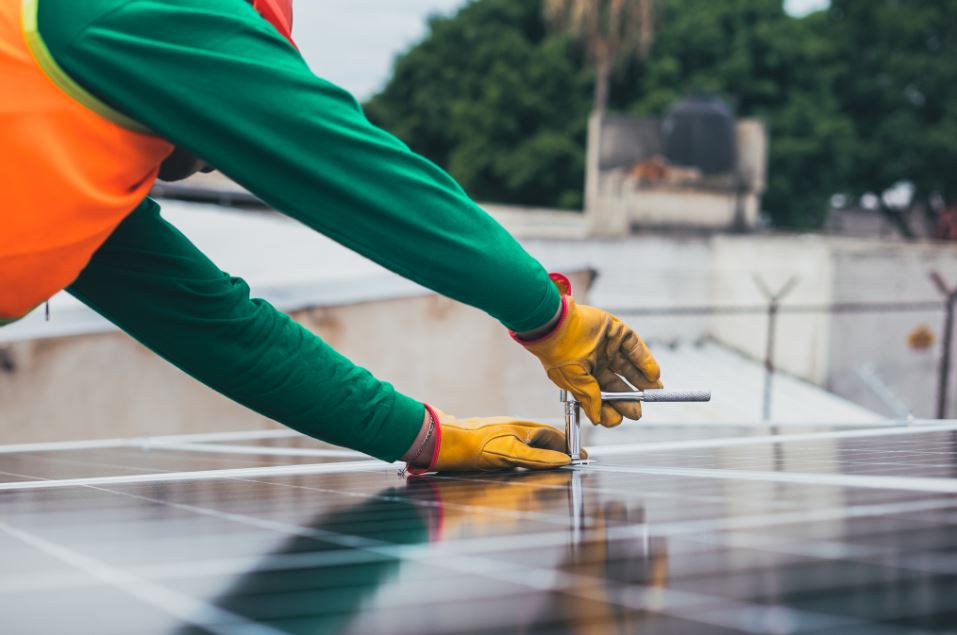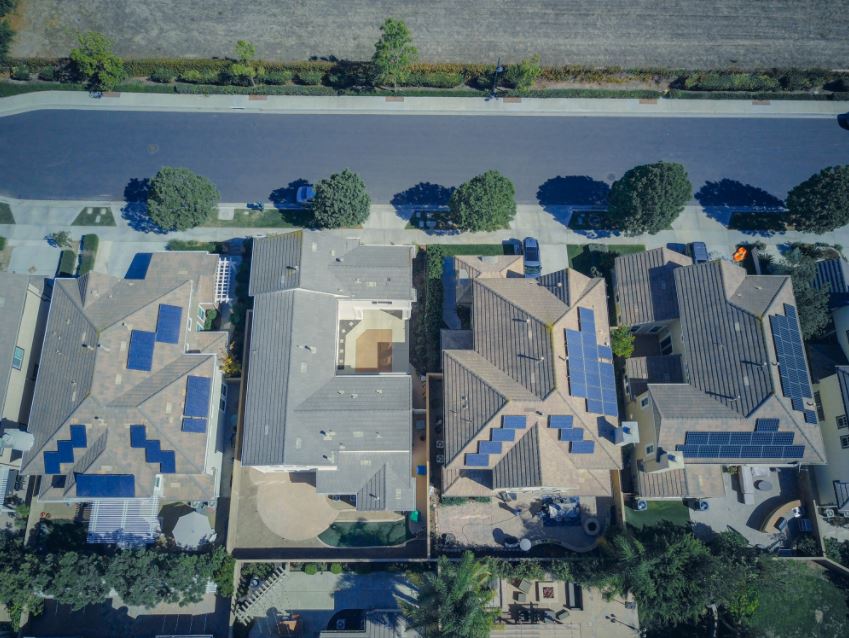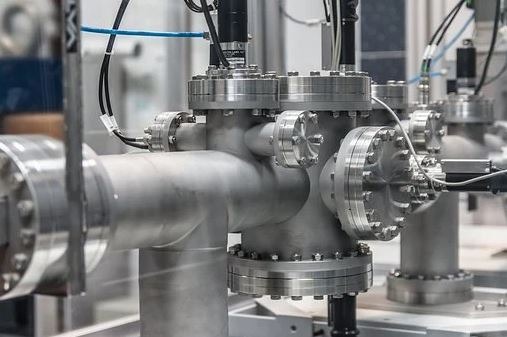Solar water heating (SWH) involves heating water with sunlight by using a solar thermal collector. A variety of configurations are available at different costs to provide the various solutions in different latitudes and climates. Solar water heating systems are used for industrial and residential applications. A sun-facing manifold heats a working fluid that passes through a storage system for later use. SWHs are active (pumped) and passive (convection-driven).
The solar water heaters use water as a working fluid. The water is heated directly or by using the concentrating light mirrors. The solar panels operate independently or in hybrid with gas or electric heaters. On the other hand, in large-scale installations, the mirrors focus the sunlight on a smaller sensor. Talking about the solar energy market, then in 2017, the global solar hot water thermal capacity was 472 GW. The market was dominated by the United States, China, Turkey, Greece, Cyprus, Austria, Barbados, etc.
What Is Solar Heater?
The traditional water heaters are directly connected to the domestic electricity network. On the other hand, solar water heaters get their energy from solar collectors. As a result, a solar heater collects energy directly from the sun. This system reduces the dependence on the electricity grid as propane gas is used for off-the-grid homes and survival. Hence, you save a lot of money and go green for the betterment of the environment. You can also check out gas or electric water heaters for more great options.
Solar water heaters are self-contained systems that do not require the installation of expensive solar panels. The solar panels generate electricity for your home, whereas, the solar water heater focuses on the production of hot water for the home’s needs. Solar heaters can be installed with panels or alone. When it comes to solar heaters, these two systems are mutually exclusive. Also check out Evolution Plumbing LLC as well.
How Does A Solar Heater Work?
A typical solar water heater consists of two parts such as a storage tank and a solar collector. Depending on the circulation pumps, the systems are classified into two categories: active or passive.
Active Solar Heaters
There are two types of active solar water heaters:
- Direct Circulation Systems
- Indirect Circulation Systems
In the active direct circulation systems, the pumps circulate the water from the collectors to the house. These systems are particularly useful in areas that do not experience a freezing climate.
On the other hand, the pumps of active indirect circulation systems circulate the heat transfer fluid that does not freeze through the solar collectors. This device is known as a heat exchanger. The exchanger then heats the water and circulates it to the house. An indirect circulation system in solar heaters is useful for the areas that experience freezing temperatures.
Passive Solar Heaters
In general, passive solar heater systems are less expensive than active solar heater systems. Also, they are known to last longer and more reliably than their active counterparts. But the passive solar heaters are not as effective as active solar heaters.
There are two different types of passive solar heater systems:
- Integral Collector-Storage (ICS) Passive Systems
- Thermosyphon Systems
Integral collector-storage passive systems work efficiently in homes. It is because they require a significant amount of hot water during the day and night. If you are planning for off-grid living during cold weather, then these solar heaters are perfect where there are rare freezing temperatures.
On the other hand, thermosyphon systems are expensive but more reliable than integrated collector-storage systems. These types of heaters require a professional installation. It is because the manifold needs to be installed somewhere below the storage tank. This design allows the water to flow as the hot water rises to the top of the tank while the cold water flows down.
As the storage tanks are heavy, you will need to hire professionals for installing the thermosyphon systems while taking the roof into account.
Components of Solar Heaters
Collector
The solar thermal collectors are there to capture and retain the heat from the sun and use it to heat the liquid. The solar thermal collectors are governed by two important physical principles and technologies.
1. The object eventually regains thermal equilibrium with the environment such as due to heat loss by radiation, convection, and conduction.
The efficiency such as the proportion of thermal energy retained for the predefined period is directly related to the heat loss from the surface of the collector. Radiation and convection are the main sources of heat loss.
On the other hand, thermal insulation is used to reduce the heat loss from a hot object. This follows the second law of thermodynamics such as the equilibrium effect.
2. If the temperature is different between the hot object and the surrounding, then the heat loss is more rapid. Heat loss is primarily governed by the thermal gradient between the ambient temperature and sensor surface. On the other hand, radiation, convection, and conduction occur more rapidly over the large gradients of thermal like a garden house.
Flat Plate Solar
Flat collectors are an extension of placing a collector in a box similar to an oven with the glass directly facing the sun, which is also one of the ways to cook when off-grid. The flat collectors have two horizontal tubes at the top and bottom known as headers along with smaller vertical tubes connecting them known as risers. The risers are connected or welded to the absorbent fins.
The heat transfer fluid such as antifreeze mixture or water is pumped from the hot water tank or from the heat exchanger to the lower manifold of the collectors. The heat transfer fluid circulates in the risers while recovering the heat from the fins of the absorber then comes out of the collector from the top header.
Serpentine flat plate manifolds differ slightly from the harp design and instead use a single tube that travels up and down the manifold. However, since water cannot be drained properly, the flat plate solar cannot be used for the drainage systems.
The type of glass used in flat collectors is almost always low iron tempered glass. Such glass can withstand heavy hail without breaking, which is one of the reasons that flat collectors are considered the most durable type of collector.
Unglazed or shaped collectors are similar to flat collectors except that they are not thermally insulated or physically protected by glass. Therefore, these types of sensors are much less effective when the water temperature exceeds the ambient air temperature.
For swimming pool heating applications, the water to be heated is generally cooler than the temperature of the ambient ceiling. In this case, the lack of thermal insulation allows drawing the additional heat from the surrounding environment.
Evacuated Tube
Another way of reducing the loss of heat is evacuated tube collectors inherent in flat plates. Since the heat loss due to convection cannot pass through a vacuum, this forms an effective insulation mechanism to keep heat in the header pipes. Since the two sheets of flat glass are generally not strong enough to withstand a vacuum that is created between the two concentric tubes.
The water pipe in an ETC is surrounded by the two concentric glass tubes separated by the vacuum which admits the sun’s heat but limits the heat loss. The inner tube is covered with a heat absorber. The lifespan of the vacuum varies from one collector to another. It can be from 5 to 15 years.
Flat collectors are generally more efficient than ETCs in direct sunlight. However, the output power of flat collectors is slightly lower than that of ETCs in cloudy or extremely cold conditions. Most ETCs are made from annealed glass which is susceptible to hailing, failing due to golf ball-sized particles.
On the other hand, the ETCs are made from the green tint known as coke glass that makes them stronger and less likely to lose the vacuum. But the effectiveness is slightly reduced due to reduced transparency. Also, the ETCs can harvest energy from the sun throughout the day at low angles due to their tubular shape.
Daily Energy Production Of 5 Solar Heaters
Technology | Flat Plate | Flat Plate | Flat Plate | ETC | ETC |
Configuration | Direct Active | Thermosyphon | Indirect Active | Indirect Active | Direct Active |
Overall size (m2) | 2.49 | 1.98 | 1.87 | 2.85 | 2.97 |
Absorber Size (m2) | 2.21 | 1.98 | 1.72 | 2.85 | 2.96 |
Maximum Efficiency | 0.68 | 0.74 | 0.61 | 0.57 | 0.46 |
Energy Production | 5.3 | 3.9 | 3.3 | 4.8 | 4.0 |
Insolation | 11.2 | 8.8 | 7.1 | 9.9 | 8.4 |
PV Pump
One way to power an active system is to use a photovoltaic (PV) panel. To ensure the longevity and performance of the pump, the PV panel and DC pump should be matched. A photovoltaic pump does not run at night. The controller must ensure it keeps running when the sun is up but the water in the collector is not hot enough. There are a few advantages of PV pumps as follows:
- Avoid carbon consumption as it uses grid-powered pumps.
- Can operate during a power failure.
- Can humidify the living space.
- The excess photovoltaic production can be used for the use of domestic electricity or reconnected to the grid.
- It is easier to install and cheaper to maintain.
Controller
A differential controller detects the difference between the temperature of the water leaving the solar collector and the water in the storage tank. When the collector is hot enough such as 8 to 10°C than the water in the tank, the controller starts the pump. On the other hand, when the temperature difference reaches 3 to 5°C, the controller stops the pump.
The controller ensures that the stored water is always heated up when the pump is running. Also, it prevents the pump from turning on and off excessively.
Tank
The simplest collector is a metal tank filled with water in a sunny location that heats the water. The configuration would be inefficient due to the balancing effect. As soon as the heating of the tank and the water begins, the gained heat can be lost to the environment and it can continue until the water in the tank reaches room temperature. The challenge is to limit the heat loss.
- The drainage tanks can be used.
- The storage tank can be located lower than the manifolds. It allows greater freedom in the system design and allows the use of pre-existing storage tanks.
- The storage tank can be hidden from view.
- The storage tank can be placed in an air-conditioned or semi-conditioned space. It helps to reduce heat loss.
Insulated Tank
ICS or discontinuous sensors reduce the heat loss by insulating the tank thermally. It is accomplished by enclosing the tank in a box with a glass cover that allows the heat from the sun to reach the water tank. The other walls of the box are insulated thermally to reduce radiation and convection. In this case, the box might be having a reflective surface on the inside.
The reflective surface reflects the heat loss from the tank back to the tank. Only, an ICS solar heater could be considered as a water tank that has been enclosed in an oven type to retain the heat from the sun. Also, the heat from the water tank is retained. Standard ICS sensors have one feature that limits the efficiency of the collector. It is a low surface area to volume ratio.
The amount of heat a tank can absorb from the sun depends mainly on the area of the tank that is exposed to the sun. It follows the size of the surface that defines the degree to which the sun can heat the water. The cylindrical objects such as the reservoir in an ICS manifold have a low surface-to-volume ratio.
Advantages Of Solar Heater
Solar heaters come with various advantages over traditional heaters.
- Lower Carbon Footprint: As compared to the PV system counterparts, solar heaters are having a lower carbon footprint.
- Low Maintenance: A solar heater can operate for more than 20 years with minimal maintenance.
- Cost Savings: Solar heaters are cheaper for large domestic installations.
- High Efficiency: More than 80 percent of the solar radiation is converted into thermal energy in the solar heaters. Hence, they are more efficient than photovoltaic panels.
- Less Space: Solar heaters require less space than solar Photovoltaic Panels. Also, fewer panels are required to heat the water than in a PV panel that is used to provide enough energy for a house.
Disadvantages of Solar Heaters
Along with advantages, there are some disadvantages to having solar heaters.
- Talking about the installation, you will always be needing a new hot water tank.
- Solar heaters require less maintenance but the pumps and antifreeze require regular maintenance just like when you want to keep your well-used vehicle covered.
- A big downside of the solar heater is that it won’t work on cloudy, foggy, or rainy days.
- For solar heaters, the panels must get direct sunlight to function.
- Sometimes it takes a lot of roof space to install the solar heaters.
- As compared to the photovoltaic counterparts, thermal solar panels are only for heating the water.
Benefits of Solar Water Heaters
There are many benefits of using solar heaters:
- Solar heating qualifies for the regular incentive income for renewable heat to produce energy from renewable resources.
- Solar heaters can work in conjunction with the existing heating or hot water boiler. Also, it works with biomass and heat pumps.
- The solar heater uses the heat from the sun. Once you have covered the initial capital costs for an installation, there are few additional costs other than the amount of electricity that runs the pumps while powering the system.
- Unlike other renewable energy solutions, solar heaters have low maintenance, are highly durable, and lower costs.
- Talking about the reduction of the carbon footprint, a solar heater can save 30 to 510kg of carbon dioxide (CO2) each year.
- Solar heaters help to cut down the utility bills. It is because it can supply one-third of the hot water needs.
- All year-round, you can have hot water with solar heaters. But make sure that you consider the extremely cold conditions in your area.
Tips For Choosing A Solar Heater
Since there are many types of solar heating systems, it might be difficult to choose the right solar power system or solar heater for your needs.
- The first step is to start with the needs of your home. Then work on the way up to the type of solar heater. Hence, you will be able to choose the perfect one while considering the various factors.
- If you don’t experience freezing temperatures, then choose a direct active solar heater system.
- Choose an indirect active system if you live in colder areas. The main reason is that these solar heaters are built to withstand the damage from extreme weather conditions such as hailing, freezing temperatures during snow, etc.
- If you are more likely to use hot water during the daytime, then choose an integral passive system. This system provides hot water in constant batches.
- If you are looking for a dual-function system to heat the pool, then an indirect circulation system with heating fluid would be the best.
- If you are having more roof space, then installing a thermosyphon system can be the best because you will be saving space inside the home.
- You can choose a solar heater depending on the amount of sunlight your home receives. It will help you to consider the temperature of hot water you will be needing every day.
- When it comes to the sunlight for solar heaters, then your roof must face the south. It means that throughout the day, the solar collectors will receive sunlight to keep the water hot in the tank. Hence, you will get maximum efficiency out of the solar heaters.
- If the roof surface does not face the south, then consider using thermodynamic panels that can be placed on either side of the house.
- For each person, you will need approximately one square meter of the collector area. It should have the capacity to heat 30 to 60 liters of water.
Applications of Solar Heaters
Domestic Sector
In the domestic sector, hot water is used for washing clothes and utensils and bathing, etc. The requirement of hot water can depend on the season of the year and also the number of family members. An individual consumes around 30 to 35 liters of water heated at 50 to 50°C. In the domestic sector, solar heaters are used in apartments, homes, and bungalows, etc.
Commercial and Industrial Sector
A large amount of water is required at a fairly high temperature in the commercial and industrial sectors. Depending on the hot water distribution model in these sectors, the solar heater systems are required to have a large capacity in a single tank system. Solar heaters are used in hotels, dormitories, hostels, hospitals, etc.
Figure 1: Data by Statista
In recent years, solar power generation has grown faster than wind power in the United States. However, among the renewable energy sources used for electricity, wind has been a more common and important source than solar power. But people are now installing solar panels or portable solar generators, solar thermal and photovoltaic energy sources for power, and solar heaters for hot water.
Solar Heaters – Hot Water With Renewable Energy Source
Solar heaters are environmentally friendly and cost-effective ways for hot water in households. When it comes to utility bills, the solar heaters reduce the expense by cutting down the grid power that is needed to generate few or large quantities of hot water. There are a variety of configurations in solar heaters. These configurations make sure that the solar heater operates at maximum efficiency without losing the heat.
The configurations of solar heaters will help you to know how to heat your home off the grid. The storage tank and solar collector are the main two parts that determine the usage of hot water in any household. On the other hand, the components of the solar heater work on the second law of thermodynamics such as the equilibrium effect. It helps to keep the water warm while moving from one part to another.

